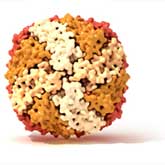Proteins Function Through Their Conformation
 To produce proteins, cellular structures called ribosomes join together long chains of subunits. A set of 20 different subunits, called amino acids, can be arranged in any order to form a polypeptide that can be thousands of amino acids long. These chains can then loop about each other, or fold, in a variety of ways, but only one of these ways allows a protein to function properly. The critical feature of a protein is its ability to fold into a conformation that creates structural features, such as surface grooves, ridges, and pockets, which allow it to fulfill its role in a cell. A protein's conformation is usually described in terms of levels of structure. Traditionally, proteins are looked upon as having four distinct levels of structure, with each level of structure dependent on the one below it. In some proteins, functional diversity may be further amplified by the addition of new chemical groups after synthesis is complete.
To produce proteins, cellular structures called ribosomes join together long chains of subunits. A set of 20 different subunits, called amino acids, can be arranged in any order to form a polypeptide that can be thousands of amino acids long. These chains can then loop about each other, or fold, in a variety of ways, but only one of these ways allows a protein to function properly. The critical feature of a protein is its ability to fold into a conformation that creates structural features, such as surface grooves, ridges, and pockets, which allow it to fulfill its role in a cell. A protein's conformation is usually described in terms of levels of structure. Traditionally, proteins are looked upon as having four distinct levels of structure, with each level of structure dependent on the one below it. In some proteins, functional diversity may be further amplified by the addition of new chemical groups after synthesis is complete.
The stringing together of the amino acid chain to form a polypeptide is referred to as the primary structure. The secondary structure is generated by the folding of the primary sequence and refers to the path that the polypeptide backbone of the protein follows in space. Certain types of secondary structures are relatively common. Two well-described secondary structures are the alpha helix and the beta sheet. In the first case, certain types of bonding between groups located on the same polypeptide chain cause the backbone to twist into a helix, most often in a form known as the alpha helix. Beta sheets are formed when a polypeptide chain bonds with another chain that is running in the opposite direction. Beta sheets may also be formed between two sections of a single polypeptide chain that is arranged such that adjacent regions are in reverse orientation.
The tertiary structure describes the organization in three dimensions of all of the atoms in the polypeptide. If a protein consists of only one polypeptide chain, this level then describes the complete structure. Multimeric proteins, or proteins that consist of more than one polypeptide chain, require a higher level of organization. The quaternary structure defines the conformation assumed by a multimeric protein. In this case, the individual polypeptide chains that make up a multimeric protein are often referred to as the protein subunits. The four levels of protein structure are hierarchal, that is, each level of the build process is dependent upon the one below it.
Fact Credit
NIH NCBI


